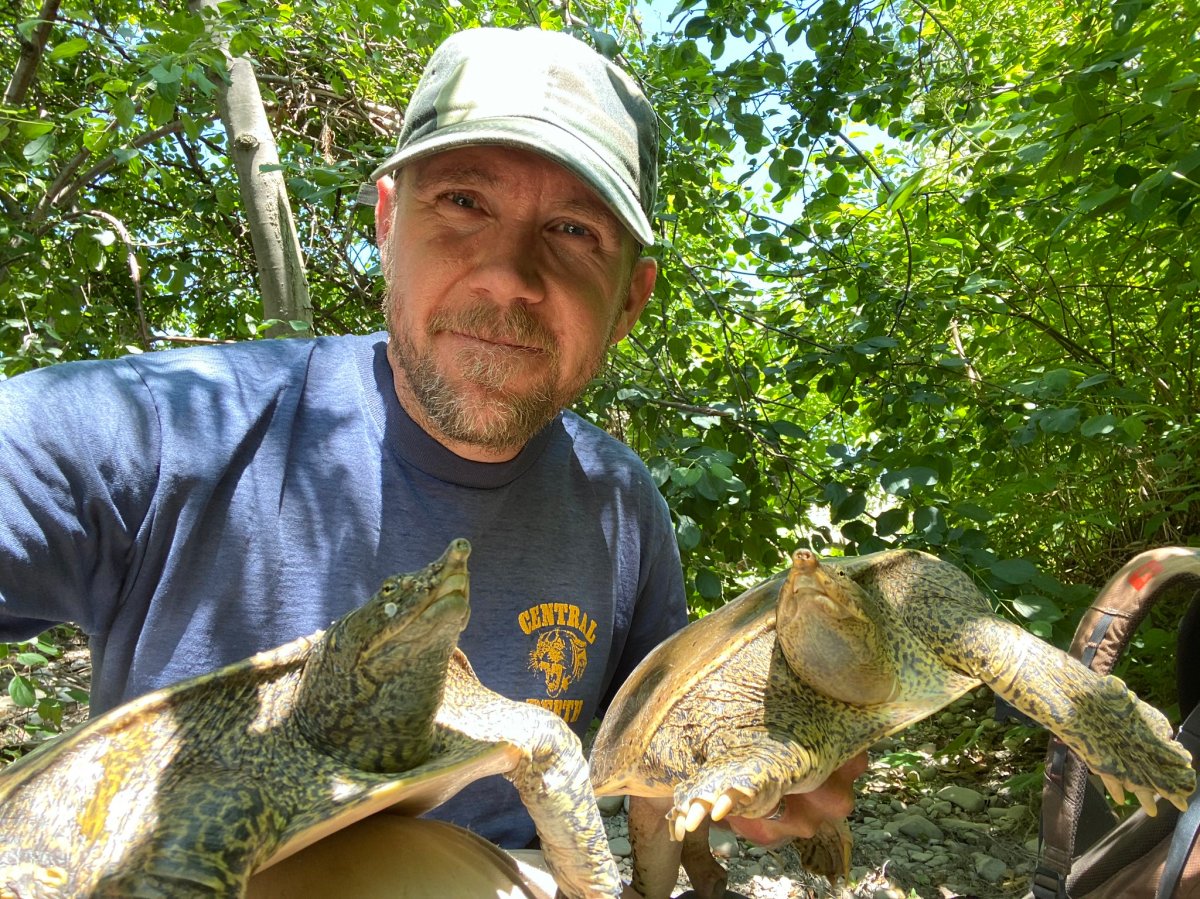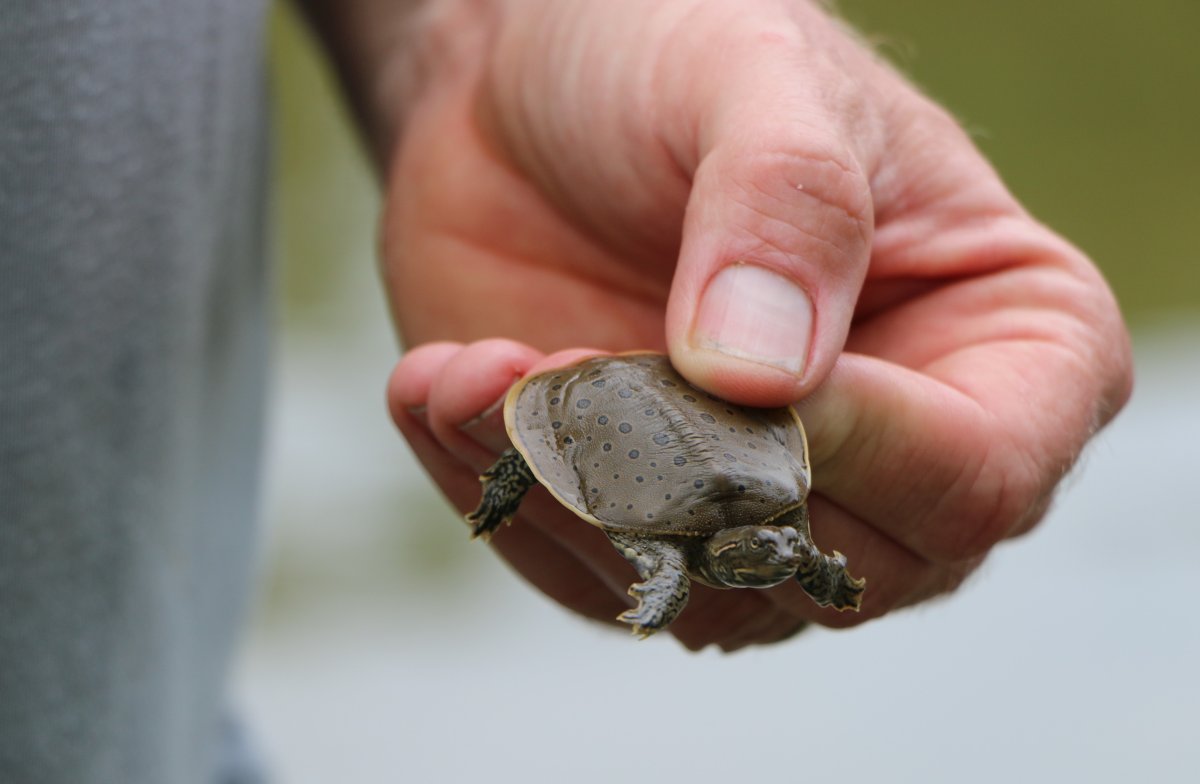Editor’s Note: This article has been updated with comments from the province received after initial publication.

Officials with the Upper Thames River Conservation Authority (UTRCA) are putting a call-out to local residents and businesses to help finance the continued operation of one of the country’s longest-running reptile research and protection programs amid a significant funding shortfall.
First launched in 1994, the Southern Ontario At Risk Reptiles program, or SOARR, has helped restore the population of southern Ontario’s once dwindling spiny softshell turtle population, along with other species, such as Blanding’s turtles, eastern hog-nosed snakes, and spotted turtles.
Since 2021, however, SOARR has had to contend with a funding gap after the Ministry of the Environment, Conservation and Parks declined to continue partially funding the program through its Species At Risk Stewardship Program (SARSP), something the province had done since 2007.
Those involved with the program submitted an application for ministry funding in February 2021, but didn’t find out until that November, after the field season was finished, that the grants, set to cover a three-year period until 2023, weren’t coming, UTRCA officials previously told Global News.
- ‘Alarming trend’ of more international students claiming asylum: minister
- TD Bank moves to seize home of Russian-Canadian jailed for smuggling tech to Kremlin
- Justin Trudeau headed to UN Summit of the Future amid international instability
- Canadian government’s satellite deal has Tories calling for Elon Musk involvement
A ministry spokesperson told Global News at the time that no project was guaranteed indefinite funding through SARSP, and that 83 funding applications had been received, with funding allocated through a competitive process involving assistance from provincial species and conservation experts.
A surprise came this past fall when members of the SOARR program, looking to apply for three-year funding as part of SARSP’s 2023-24 season, learned that conservation authorities — and, by extension, programs affiliated with them — were no longer eligible to apply.
“Although we are a grassroots program and our funding comes from outside sources, because we are attached to the conservation authority, in some ways, we no longer are able to get provincial funding,” said Scott Gillingwater, a species-at-risk biologist with UTRCA, who has been involved with the SOARR program since it began.
“Unfortunately, it was decided that because we’re associated with the conservation authority, that we’re not eligible… That was a big chunk of funding that was dedicated for species at risk that we no longer have access to.”
Although SOARR receives financial support from the federal government and local partners, the provincial dollars accounted for roughly 36 per cent of its total funding. As a result, between $30,000-$50,000 per year, maybe more, will be needed to keep SOARR operating at normal capacity, Gillingwater says.
Members of the community stepped up early last year to help the long-running program after SOARR’s provincial funding application was denied, Gillingwater said, noting that a generous contribution from an anonymous donor allowed the program to continue on and see a fundraising effort launched.

Get breaking National news
“We have a small buffer, but once we’re out of money from that buffer, we can’t continue. So it is going to be an ongoing struggle to ensure that we have funding for each year moving forward,” he said.
The hope is for more consistent funding, particularly if those contributing do so for several years, he says.
“That will ensure a safety net for this program, and one that will allow us to plan for the future, because not only are we working with species at risk in the field… but we’re also working with the community and providing education programs,” Gillingwater said.
It wasn’t immediately clear to Gillingwater why conservation authorities were deemed non-eligible.
In a statement to Global News, a spokesperson for the Ministry of the Environment, Conservation and Parks said that conservation authorities were deemed non-eligible applicants in September, and that guidelines for SARSP were updated annually, giving the province “an opportunity to identify annual funding priorities and make program-related adjustments as needed.”
Asked why conservation authorities were removed from eligibility, the ministry replied, “The government wants to ensure conservation authorities are focused on their core mandate of helping protect people and property from the risk of natural hazards, the conservation and management of conservation authority-owned lands, and their roles in drinking water source protection.”
A response was not provided to an inquiry about whether any other groups or organizations had been dropped from eligibility.
Two other avenues of potential funding exist, the spokesperson said, namely the Great Lakes Local Action Fund and the Wetlands Conservation Partner Program.
More information on how to support the Southern Ontario At Risk Reptiles program can be found on the UTRCA website.
The province has been criticized in recent years for legislative changes that environmental groups and others have charged have helped weaken the role of conservation authorities, including last year with Bill 23, the “More Homes Built Faster Act,” which saw amendments to the Conservation Authorities Act.
Passed in November as part of the Ford government’s plan to build 1.5 million homes in 10 years, critics said the legislation would weaken conservation authority powers and reduce their role in development applications, lead to higher property taxes, and not actually make homes more affordable.
In a letter to the province, Conservation Ontario, which represents the province’s 36 conservation authorities, raised concerns that the bill delegated the regulatory responsibility of conservation authorities, such as flood management, to municipalities.
As a result, the bill, they said, would weaken the ability of conservation authorities to protect people and property from natural hazards, and would “diminish the ability to protect critical natural infrastructure like wetlands that reduce flooding and protect water quality in lakes and rivers.”
The province also introduced Conservation Authorities Act changes in late 2020 with the passing of Bill 229, the “Protect, Support and Recover from COVID-19 Act,” an omnibus COVID recovery bill which received Royal Assent in December 2020.
The bill had received pushback from conservation authorities, who said it would force them to issue a development permit, “even if it goes against their provincially-delegated responsibility to protect people, infrastructure and the environment.”
In 2019, legislative changes under the “More Homes, More Choice Act,” which received Royal Assent in June 2019, gave municipalities more authority over conservation authorities, according to the Association of Municipalities Ontario.
Earlier that year, the province cut conservation authority funding for flood programs in half.
— With files from The Canadian Press













Comments